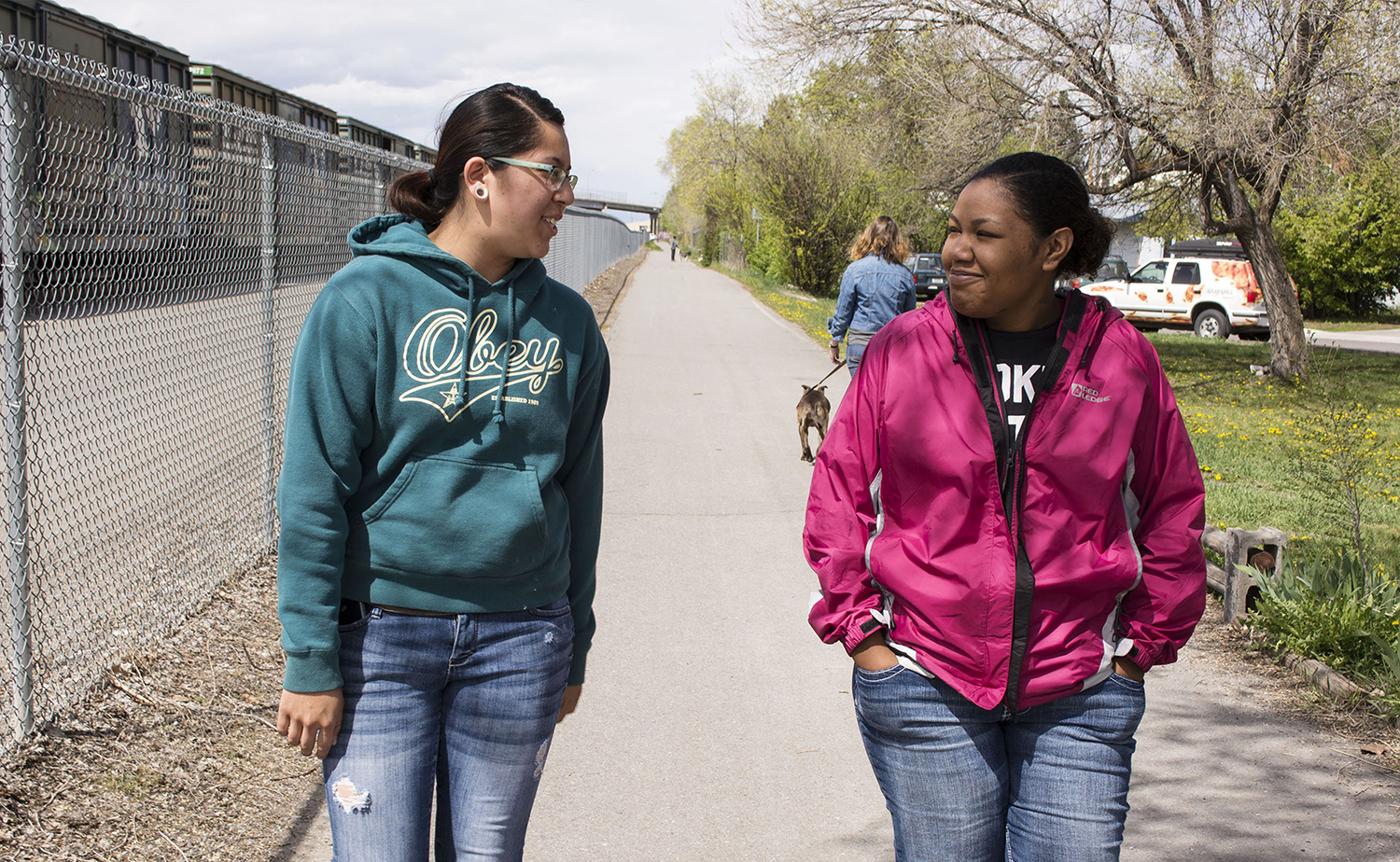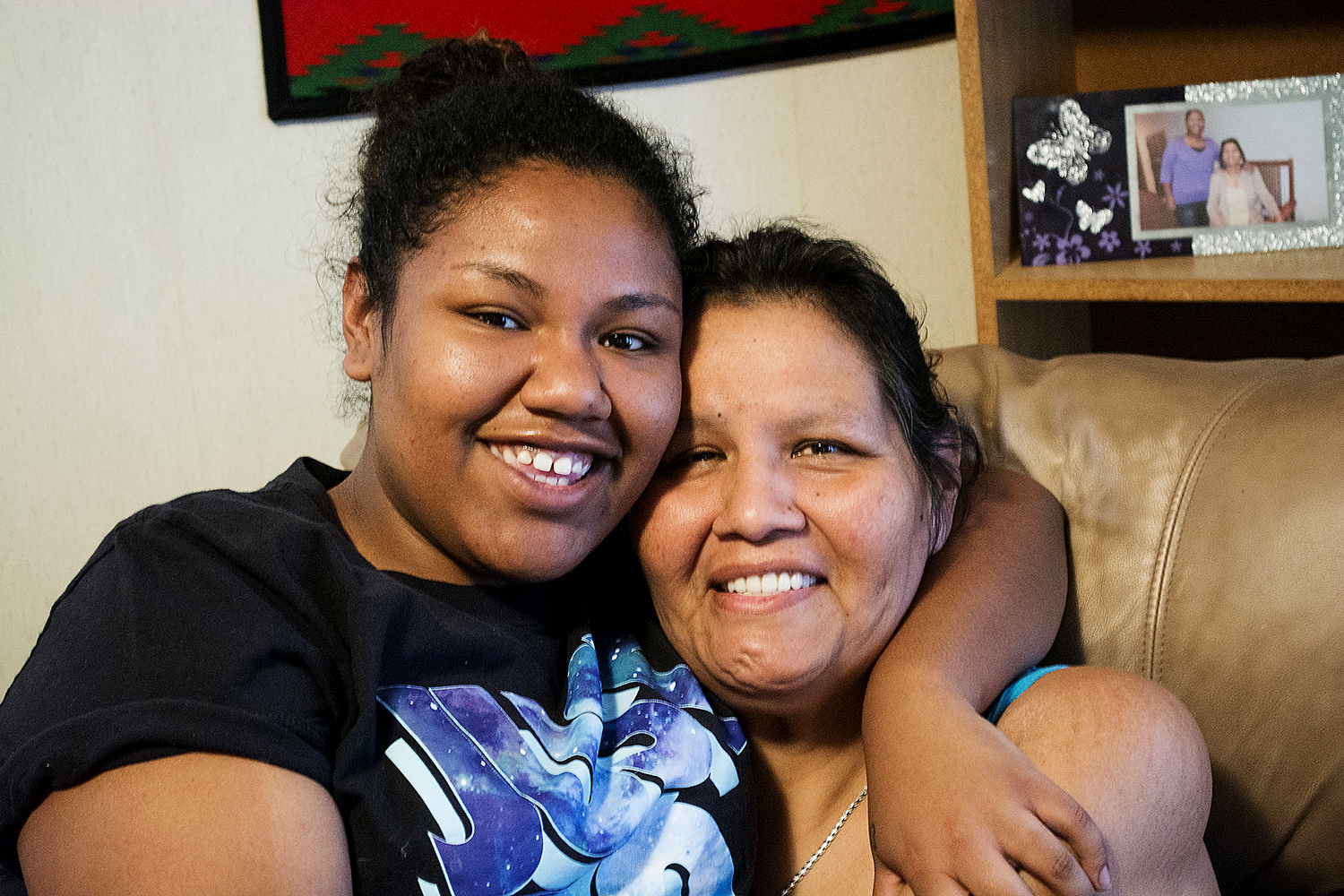Script
How does she keep a word from hurting her? She owns it.
29:36 An apple is an urban Native American, it’s a slang word. It’s kind of derogatory,
Enlarge

That voice belongs to Shania Hall, she’s a member of the Blackfeet nation. She sits forward on her couch, the excitement in her voice and the look in her eyes behind thin-framed glasses hint at embarrassment as she describes how she and Michaela Frazier, of the Northern Cheyenne tribe would put on fronts to live up to be what they describe as a real “en-din” kid.
1:23 just kind of assimilated to white culture I guess. That’s what an apple is. Thats what I define an apple as.
27:31 White on the inside means you’re raised white but you look Native on the outside.
29:57 I would consider myself an apple which isnt a good thing because I was born and raised in Missoula but I try to front like I’m straight from the rez.
Enlarge

The two girls met in class in middle school, and became fast friends, sharing the split identity of Native American teens who grew up away from their families and the submerging culture that is reservation life. It’s been a struggle and they’re not alone:
According to the 2010 census, 78 percent of all Americans who identify as Natives are living off reservations. That means as urban Natives, the girls are living like the majority. When they were kids, the duo talked about wanting to go back to the reservation and live. Michaela has always wanted to attend St. Labre Indian School in Ashland despite warnings by her mom, Elaine Littlebird, who grew up there.
1:47 Its funny because its like, okay Labre. She wanted to go back to the ‘rez’ to go to school and I’m laughing at her cause I’m like, no you dont, no you dont.
1:45 I wanted to go to school there so bad. It hurt me, it hurt my heart.
Shania actually went back to Browning after high school. Her experience is hardly the romanticized homecoming she dreamed of.
13:58 Since I’m living there, it’s kind of dawned on me, like I’m done. I’m sick of it.
14:07 I miss home, I miss hiking, and granola people. I miss Missoula people.
Despite what Shania has told her about reservation life, Michaela remains hopeful about one day moving back to Ashland.
On the reservation, they feel outcasted. But they never quite fit in in Missoula either, Michaela explains…
Enlarge

1:35 You have so many kids that come from the rez, like really rez. and then they look at all the kids that were raised here and they’re like “look at you guys, why do you guys talk so nice and what are you trying to do, be fancy?”
Jake Arrowtop, with the Montana Indian Education program, works with the students who move from the ‘rez’ to Missoula county. He provides some insight as to why some of these kids would be inclined to call someone an apple.
19:10 They are just challenging what an authentic Indian is, you’re not authentic if you didn’t grow up on the rez, I supposed. It’s a pretty mean thing to say to somebody.
Michaela and Shania would walk the halls of their school other Native American kids would call them apples. Shania looks like a native kid with high cheekbones lifting her dark brown eyes. Her complexion is naturally tan and her black hair is so thick she can wrap a hair tie around it just once and it’ll hold. In her opinion, she is an apple because of the way she talks. In Browning, where her family is from, accents are thick and slang is abundant, she stands out because her voice is clear and shows no signs of an accent. She calls that ‘talking white’.
4:32 Here’s something that my cousin said, ‘like you don’t even talk rez, you talk so white.’
4:42 I tried so hard to pick up an accent and then when I came back to Missoula, everyone made fun of me
Michaela is on a different end of the Native spectrum. She is only half Northern Cheyenne, the other half is African American on her father’s side. She is much darker in complexion and her tight, dark brown curls give her an afro-esque feature. It’s the subtle things that make Michaela stand out with Native characteristics, from her wide, flat feet to her high cheekbones and even the hint of a Native drawl she picked up from listening to her mother speak. But even with those physical characteristics, to the other kids who grew up on reservations before moving to Missoula, these girls were posers, wannabe native kids. To themselves, they were just kids.
6:34 We weren’t standing on our soap boxes or whatever like, ‘Hey! We’re indians!” We just did what was required of us or we thought we should do to kind of honor our tribes individually.
Shania explains how she personally represents her culture by learning prayers and participating in traditional Blackfeet sweat lodges. For Michaela, her representation of culture means to hike with her friends in the wilderness, and make fry bread and stew with her mother. She and her self proclaimed ‘P-I-C’ -partner in crime – find their own ways blend Native heritage with their Missoula roots.
Enlarge

There’s an average of about 9,000 Native Americans living on each Montana reservation. In Missoula, they make up only two-and-a-half percent of the population, which adds up to just under 3000 enrolled Natives.
Cecil Crawford, a school counselor with the Indian Education program, says its a culture shock for the kids coming off the rez and that sometimes causes them to lash out.
Cecil also knows Michaela and Shaina well and recalls their senior year at Hellgate.
27:16 They struggled. We used to have to chase Shania around to get her work done.
27:23 What saved her is art.
Last August, Shania’s mother passed away from a rare form of cancer known for eating away it’s victims bones, she said the experience was brutal…
23:46 It happened so fast, people were shocked. Like her brother still doesn’t know because he’s in prison in Washington.
16:35 She was the eldest so she kept everyone together and since then they’ve been dropping like flies. She just kind of kept people in check you know?
After her mom died, Shania decided to move back to Browning. She lives with her aunt off and on before heading off to The Art Institute of New Mexico on a full ride scholarship. Living in Browning makes her homesick so sometimes she drives back to Missoula to stay with her sister and see her friends.
Her eyes squint from the grin on her face as she starts to remember stories of their recently graduated high school days.
6:22 Hanging out? Me and Michaela used to the this, we used to try to act hard core like, aw we’re native and then we’re actually like born and raised in Missoula so we would try and walk around our school like badasses but it was not working.
The two so-called apples are about to split ways this fall when Shania moves to New Mexico for art school. Michaela plans to remain in Missoula for now to work on a degree in social work. No matter where they end up, the girls plan to stay in contact and carry with them the bits and pieces of Native traditions and urban lifestyles that make up their own unique flavor of culture.
An apple culture.
For the Montana Native News Project, I’m Cheri Trusler.
